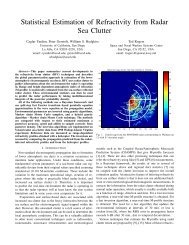Statistical Estimation and Tracking of Refractivity from Radar Clutter
Statistical Estimation and Tracking of Refractivity from Radar Clutter
Statistical Estimation and Tracking of Refractivity from Radar Clutter
Create successful ePaper yourself
Turn your PDF publications into a flip-book with our unique Google optimized e-Paper software.
19<br />
becomes large at high altitudes making the narrow-angle scheme inaccurate at<br />
more than a few kilometers. However, the form given in (1.29) totally satisfies all<br />
accuracy needs <strong>of</strong> the lower atmospheric narrow-angle ducted propagation environments<br />
simulated in this work.<br />
1.3.2 <strong>Radar</strong> Sea <strong>Clutter</strong> Calculation Under Non-St<strong>and</strong>ard Propagation<br />
Conditions<br />
Using the classical radar equation, received radar clutter power can be<br />
written as<br />
P c<br />
= P tG 2 t λ2 F 4 σ<br />
(4π) 3 R 4 , (1.32)<br />
where P t is the transmitter power, G t is the transmit antenna gain, λ is the wavelength,<br />
σ is the sea surface radar cross section (RCS), R is the range, <strong>and</strong> F is the<br />
propagation factor (ratio <strong>of</strong> the electric field at a point to that which would have<br />
been created by the same system operating in free space with the on-axis gain <strong>of</strong><br />
the antenna) [15]. After F is calculated at the effective scattering height given as<br />
0.6 times the mean wave height [16], the one-way propagation loss L then can be<br />
written as<br />
L fs<br />
L = L fs /F 2 (1.33)<br />
= (4πR)2<br />
λ 2 , (1.34)<br />
where L fs is the free space loss. Sea surface RCS can be written as σ = A c σ o ,<br />
where A c is the illuminated area (proportional to R at small grazing angles) <strong>and</strong><br />
σ o is the normalized sea surface radar cross section (RCS). Then the clutter power<br />
can be written as<br />
P c<br />
= P tG 2 t 4πA cσ o<br />
L 2 λ 2 (1.35)<br />
P c = Cσo R<br />
L 2 (1.36)<br />
P c,dB = −2L dB + σ o (R) dB + 10 log 10 (R) + C dB , (1.37)




